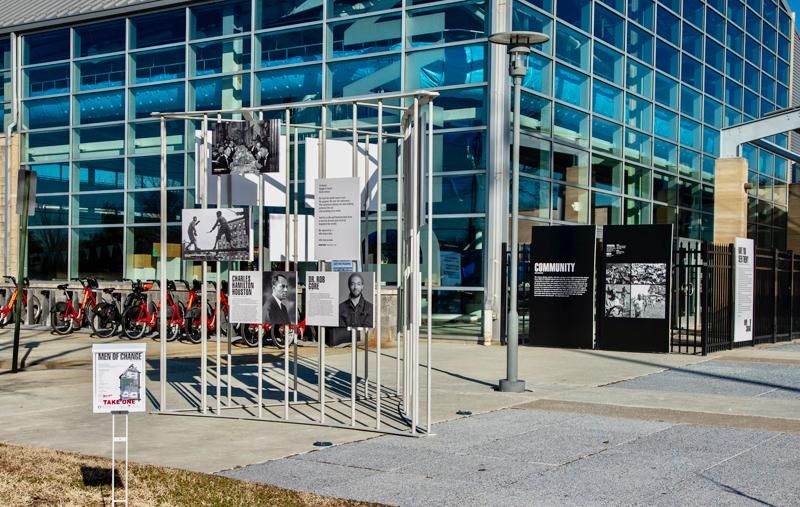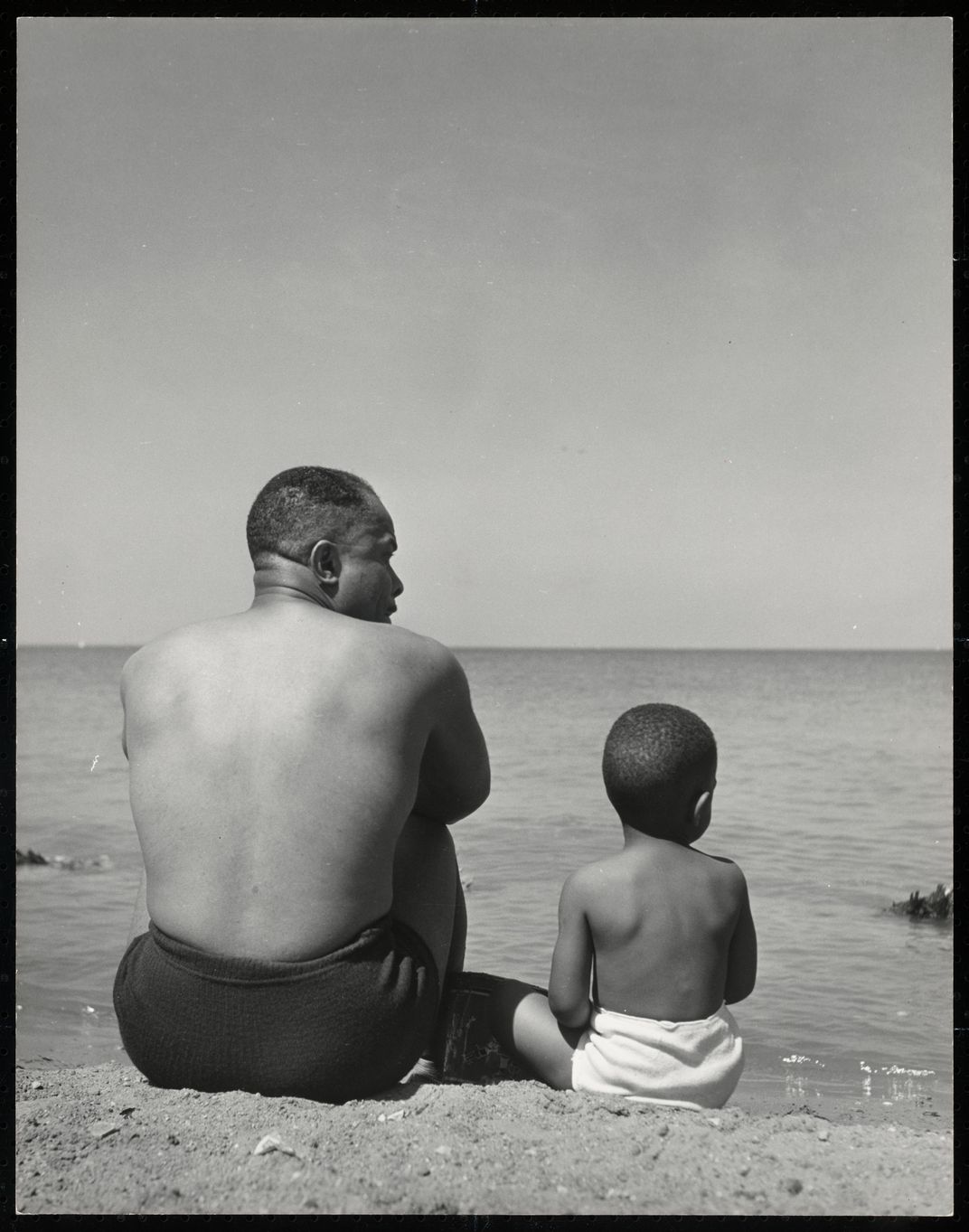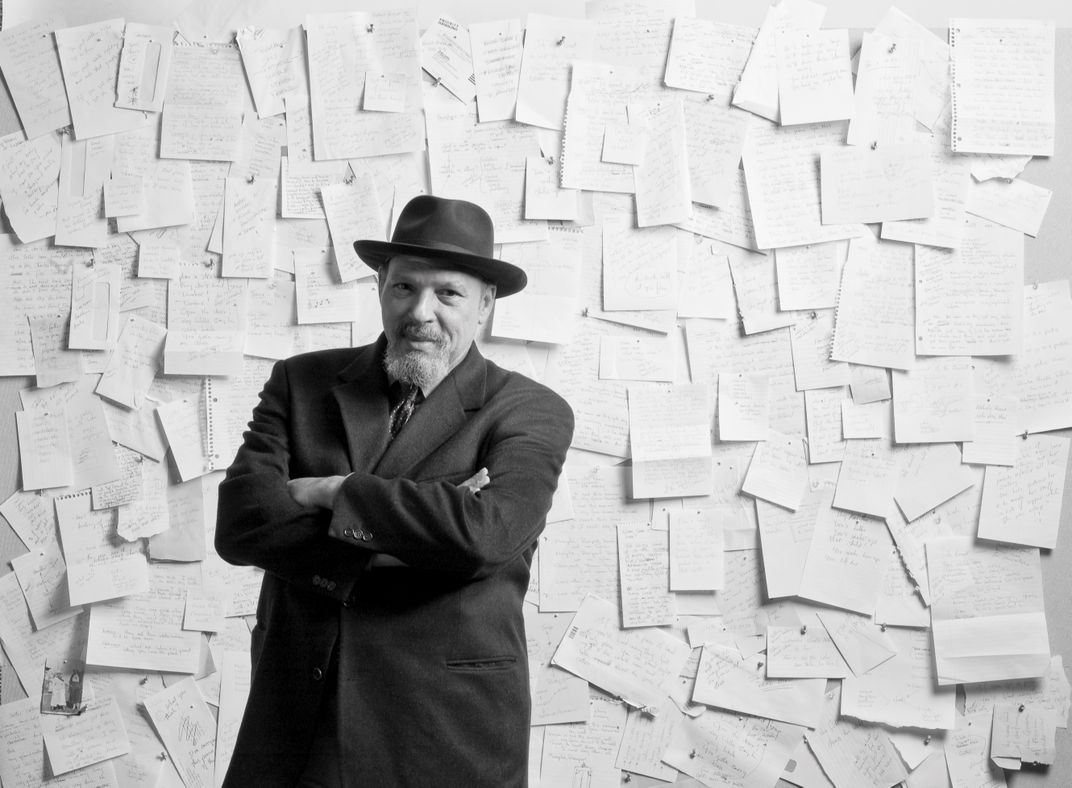When the city isn’t operating under pandemic restrictions, the block that unifies Meade and 49th Streets in northeast Washington, D.C. is typically vibrant with activity. On one end, the Deanwood Community Center houses a public library, indoor pool and multipurpose spaces; on the other, scholars from the all-male Ron Brown College Preparatory High School, outfitted in their requisite striped ties and sports coats, busy the sidewalks on weekdays of ardent learning. Now in Mayor Muriel Bowser’s phased response to COVID-19, the community center and school are both closed. Stillness consumes the block, minus occasional pedestrians making their way past in one direction or the other.
Bookended by two people-serving institutions, the location is ideal for Anacostia Community Museum’s newly installed outdoor exhibition, “Men of Change: Taking It to the Streets,” a narrative and visual celebration of black manhood articulated across an eight-stop walking tour.

Featuring familiar names and faces—Muhammad Ali, Lebron James, Ta-Nehisi Coates, W.E.B. DuBois, James Baldwin, August Wilson—the exhibition is intentional to also honor the extraordinary love and importance of everyday sons, fathers, brothers, educators, neighbors, leaders, men whose names will likely go unincluded in textbooks and historical recounts but whose lives are threaded into the fabric of their respective black communities.
“When I saw this block in particular, it actually reminded me of the exhibit. One of the themes you'll see is that none of these guys stand alone. They come from a legacy of other people whose shoulders they stood on. And I feel like this block is like an ecosystem of support,” explained Andrea Jones, associate director of education at the Anacostia Community Museum. “There’s a recreation center that holds classes and has homework time, even during the pandemic, and there’s a high school that is basically an incubator for men of change. I just feel like this block amplifies all of the messages expressed in the exhibit.”

The original installation, “Men of Change: Power. Triumph. Truth,” was scheduled to travel from Los Angeles’ California African American Museum in December to enjoy a three-month residency in the Anacostia Community Museum in southeast D.C. The pandemic required a strategic change of plans following the reclosure of all Smithsonian buildings in November, but administrators got creative to avoid a complete cancelation. The redesigned approach brings the museum to the block in a walkable tour divided into seven themed displays to highlight the stories of two dozen black men in politics, sports, science, entertainment, business and religion. They are heroes—some of them globally, some of them locally—and they represent pride, tenacity and possibility.
“We are so excited about this exhibition. It was originally designed to be indoors at our museum but because of COVID-19, we were not able to do that. We really felt that this content was so important—not only because of the content that it is, but also the time period right now and its emphasis on African-American men and their contributions to society—that we've spent the last few months re-imagining the exhibit and putting it up in the community,” says Melanie Adams, director of the Anacostia Community Museum.

One positive outcome of the pandemic: outdoor art displays and curated exhibitions are having a moment. The University of Houston launched a self-guided, interactive tour of “Color Field” to the public through May 2021 as an escape from the sofa. The two-acre sculpture garden at The Aldrich Contemporary Art Museum in Ridgefield, Conn., has been a respite for cabin fever, much like the one at the Hirshhorn in Washington, DC, and the outdoor installations at The Bass Museum of Art in Miami Beach. It’s a bonus for communities of color where galleries and museums are few and far between.
With support from the Ford Motor Company, the DC Commission on the Arts and Humanities, and the Smithsonian Women’s Committee, the “Men of Change” exhibition will be on display until May 31, 2021. The Deanwood location was intentionally selected to inspire and mirror the genius of the young black men at Ron Brown—DC Public Schools’ first single-gender, all-male-of-color high school—but its placement is also an opportunity to broaden the understanding of African American culture, society and history on the streets of a black community, adds Marquette Folley, content director for the Smithsonian Institution Traveling Exhibition Service and the creator of “Men of Change.”

“When we decided to think about content for an exhibition, it happened to be around a time there was a wave of actions perpetrated against black male bodies. It’s a problem when we don't realize the brilliance around us simply because we have particular biases,” says Folley. “The Smithsonian Institution tells American stories. We tell stories that say, ‘Here's our brilliance, here's how we rise.’ This exhibition is that kind of story. It speaks to simply say, ‘open your eyes.’”
Black History Month is a commemoration of a people’s shared and collective journey, a purposeful pause every February to more deeply explore and learn something new about the black experience. This exhibition, where history meets contemporary, also honors the right now—an additional section allows students and community members to designate and honor local men of change. Administrators hope the exhibition’s spirit and storytelling will continue to keep people socially connected even after the community center and school reopen, and the block is once again vibrant with normalcy.
“I have made my career as an educator and I always think about what kids are learning when they first start out. I don't know about you, but this stuff was not taught,” says Jones. “It was not part of the curriculum. And I feel like it being on display here is really proof that these stories have been invisible in some ways. So I'm really excited to have it out here.”
“Men of Change: Taking it to the Streets” is on view through May 31 in Washington, D.C., along six streets in the neighborhood adjacent to the campus of Ron Brown High School at 4800 Meade Street, N.E. Take Metro to the Deanwood station.
/https://tf-cmsv2-smithsonianmag-media.s3.amazonaws.com/filer/ca/9d/ca9dbf5f-3f77-4b23-80a6-8113b125b708/longform_mobile.jpg)
/https://tf-cmsv2-smithsonianmag-media.s3.amazonaws.com/filer/f0/11/f0110487-e185-4dec-82cd-e805172651ce/longform_desktop-1.jpg)
/https://tf-cmsv2-smithsonianmag-media.s3.amazonaws.com/accounts/headshot/janelle.png)
/https://tf-cmsv2-smithsonianmag-media.s3.amazonaws.com/accounts/headshot/janelle.png)